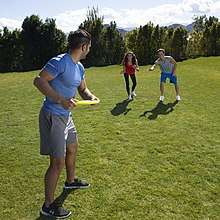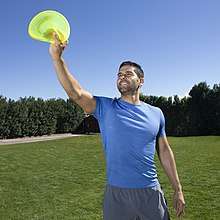Aerobie
An Aerobie is a flying ring used in a manner similar to a chakram or flying disc (Frisbee), for recreational catches between two or more individuals. Its ring shape of only about 3 mm (0.12 in) thickness[1] makes the Aerobie lighter and more stable in flight than a disc.[2] It can be bent to tune it for straighter flight.[3] Since it has very low drag and good stability, it can be thrown much farther than a flying disc. The Aerobie was used to set two former world records for thrown objects.

Designed in 1984 by Stanford engineering lecturer Alan Adler, the Aerobie has a polycarbonate core with soft rubber bumpers molded onto the inner and outer rims. The outer rim has a spoiler designed to impart stability.[4]
"Aerobie" also refers to other products made by Aerobie, Inc.
History
In the 1970s, Alan Adler began attempting to improve the flying disc, considering its design characteristics. He tried streamlining the shape to reduce drag, but this resulted in a disc that was more unstable in flight. Eventually, inspired by British accounts of deadly Indian weaponry and martial arts, he turned his attention to the ring shape of the Chakram, a formidable Punjabi weapon used by the Sikh of India. This led to the development of the predecessor of the Aerobie, which was called the "Skyro".[5] About a million of this model were sold. In 1980, it was used to set a Guinness World Record throw of 261 metres (856 ft). It lacked the spoiler rim of the Aerobie. It had low drag but was stable at only a certain speed. The later introduction of the spoiler, which balanced the lift, made the ring stable "over a wide range of speeds".[6] After testing several models, the ideal shape was found, and the Aerobie was produced. Adler founded Superflight, Inc. (now known as Aerobie, Inc.) in 1984. Since then, Adler and the company have produced 12 other sport toy products.[7]
Characteristics
The Aerobie allows for throws over unusually long distances. It flies faster and farther than a common flying disc. When well tuned, it can fly in a straight line,[1] "like a puck on an invisible sheet of ice".[8] It does not have the tendency to roll when thrown level, as a flying disc does.[9] But similarly to a disc, an Aerobie can be thrown in a curved path by throwing it in a slant.[9] Its lift depends on its speed relative to the air. Therefore, throwing into the wind makes it fly higher. Throwing with the wind makes it fly lower.[10]
Advantages
The Aerobie's ring shape allows it to be caught in a variety of different ways. For example, it can be caught by thrusting a forearm,[10] the head (when the ring is thrown high),[11] or even a foot[10] through the middle. Games such as "Aerosticks"[12] and Aerogoal[13] are designed specifically for the Aerobie.
Disadvantages, special care
An Aerobie ring does not float in water.[14] It can be easier to lose than a flying disc, especially over long distances: its low profile can make it hard to spot on the ground, and, in particular, it gets caught on tree branches more easily.[10]
The Aerobie is best thrown in a wide open area such as a football or soccer field, away from bodies of water, roofs, trees, roads, etc. Adequate light is important.[9]
World records
The 13 inch (33 cm) Aerobie Pro was used to set the Guinness World Record twice for the "longest throw of an object without any velocity-aiding feature".[15] The Aerobie's first Guinness World Record was set by Scott Zimmerman at 1,257 feet (383 meters) in 1986 at Fort Funston, San Francisco.[16] The 1986 record was broken by Erin Hemmings with a throw of 1,333 feet (406 meters) on July 14, 2003 at Fort Funston. Hemmings' Aerobie was airborne for 30 seconds (not an official measurement) and was the first thrown object to break the quarter-mile barrier (402 meters or 1,320 feet).[17]
Previous to the 1986 record, the Aerobie held the world record at 1,046 feet 11 inches (319.10 meters). It does not appear that this was recorded by Guinness.[18] On June 7, 1988, the Aerobie became the first object to be thrown across Niagara Falls with a throw by Scott Zimmerman.[19] In April 1987, Zimmerman threw a silver dollar taped to an Aerobie across the Potomac River.[20]
Since the introduction of the Aerobie, Superflight has offered reward money for various landmark throws. While details of the earlier rewards are unclear, the current reward is $1,000 to anyone who sets the Guinness World Distance Record.[15]
Aerobie products

Current list of products
- Aerobie Pro ring
- Aerobie Sprint
- Aerobie Medalist
- Aerobie Orbiter boomerang[21]
- Aerobie Superdisc
- Aerobie Skylighter 12
- Aerobie Squidgie Disc
- Aerobie Dogobie disc; designed for dogs to catch
- Aerobie Rocket football
- Aeropress
See also
- Chakram (Indian Sikh - thrown weapon)
- Boomerang
- Disc Golf
- Ken Westerfield (flying disc pioneer)
- List of disc golf manufacturers
Further reading
- Lorenz, Ralph (2006). Spinning flight: dynamics of frisbees, boomerangs, samaras, and skipping stones. Springer Verlag. ISBN 978-0-387-30779-4.
References
- "The Science of Aerobie Sport Toys", #1 Archived October 11, 2011, at the Wayback Machine, accessed June 26, 2008
- Schuurmans, Mace "Flight of the Frisbee", New Scientist, accessed June 26, 2008
- "Aerobie Pro and Sprint ring FAQs", #2 Archived September 6, 2011, at the Wayback Machine, accessed June 26, 2008
- aerobie.com image Archived November 9, 2007, at the Wayback Machine, accessed June 26, 2008
- Cassidy, John (1989). The Aerobie Book: An investigation into the Ultimate flying mini-machine. Klutz Press. pp. 28–31, 44. ISBN 0-932592-30-9.
- Adler, Alan "The Evolution & Aerodynamics of the Aerobie Flying Ring" Archived May 23, 2008, at the Wayback Machine, accessed June 26, 2008
- "The History of the Aerobie Brand", accessed June 26, 2008 Archived May 13, 2008, at the Wayback Machine
- Cassidy, John (1989). The Aerobie Book: An investigation into the Ultimate flying mini-machine. Klutz Press. p. v. ISBN 0-932592-30-9.
- "Aerobie Pro and Sprint ring FAQs", #1 Archived June 30, 2008, at the Wayback Machine, accessed June 26, 2008
- Cassidy, John (1989). The Aerobie Book: An investigation into the Ultimate flying mini-machine. Klutz Press. pp. 12–13. ISBN 0-932592-30-9.
- Translated Korean Aerobie site, accessed June 27, 2008
- "Aerosticks: The Art of Catching Aerobies with Sticks", copy at the Internet Archive
- Cassidy, John (1989). The Aerobie Book: An investigation into the Ultimate flying mini-machine. Klutz Press. p. 21. ISBN 0-932592-30-9.
- "Aerobie Pro and Sprint ring FAQs", #3 Archived June 30, 2008, at the Wayback Machine, accessed June 26, 2008
- "Aerobie Pro and Sprint ring FAQs", #8 Archived June 30, 2008, at the Wayback Machine, accessed June 26, 2008
- "First Quarter Mile Throw in History at Fort Funston". Business Wire. Business Wire. 2003-07-16. Retrieved May 28, 2009.
- New World Record, accessed June 26, 2008
- "Ringing in a world record". Science News. March 9, 1985. Retrieved December 21, 2009.
- "California college student throws Aerobie flying ring across Niagara Falls". PR Newswire. June 7, 1988. Retrieved December 21, 2009.
- "Scott Zimmerman, Aerobie champion, dressed as George Washington, successfully throws a silver dollar across the rain-swelled Potomac River with the coin taped to an Aerobie". PR Newswire. April 21, 1988. Retrieved December 21, 2009.
- Aerobie Sport Toy Products Archived June 1, 2008, at the Wayback Machine, accessed June 26, 2008
External links
- Official website
- U.S. Patent 4,560,358 by Alan Adler, filed May 10, 1984, issued December 24, 1985.
- Youtube Video Video of Aerobie products in action, including throwing one of the rings out of the Aloha Stadium in Hawaii, and the demonstration of the Aerobie Orbiter
- Official Hungarian Aerobie Website